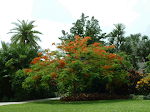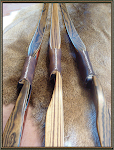Tuesday, December 9, 2008
This weeks Tuesday Tip is about Winterizing the garden. Winterizing your garden is necessary for a healthy garden. So here are some tips on getting the job done.
Remove weeds, debris and invasive plants.
Fall is when weeds go to seed -- pods and seed cases burst open to release them. If you don't have time to rake up crab apples, try collecting them with a shop vacuum. If there's no time to pull plants up by the roots, chop or clip off their heads before the seeds are released. Discard all seed heads in the trash pile, not on the compost heap. If you have a large weed patch, solarize it through winter by covering it with a large sheet of black plastic weighted down by bricks or rocks.
Every once in a while, a garden plant finds the legs and begins to spread and take over the garden. By fall, it will have long worn out its welcome -- whether it's Japanese knotweed invading a shrub border or forget-me-nots running rampant through perennial beds. Dig or pull intruders out completely and dispose of them. Or spot treat them with an herbicide. Follow label precautions regarding when and how to spray. And be careful not to overspray and affect innocent plants nearby.
Prepping your soil to give plants a head start in spring is always a good idea.
After you have removed all of your garden debris, weeds and invasive plants, it's easy to prepare your beds for spring. There are advantages to testing the soil and amending it in fall. You'll have plenty of time to add needed amendments to the soil before cold weather sets in. The cool weather makes autumn a nice time to break new ground. Top beds off with a 3- or 4-inch layer of compost and leave it. Winter rains will leach nutrients into the soil to give your plants a head start in the spring, and when you prepare the soil, the topping will be easy to work into the soil at planting time.
Divide perennials now to ensure a trouble-free spring.
Fall is a very good time to divide perennials for gardeners in most parts of the U.S. The plants are going dormant at this time and won't be shocked by cutting, chopping or transplanting. And the weather conditions are congenial -- the soil is still warm and autumn rains will supply a steady supply of water to the transplants. In the spring, they'll repay your efforts with a fresh, vigorous start. Spring is better for division in freezing climates, where winter temperatures are hard on transplants.
How can you tell if a plant needs dividing? Many perennials benefit from division every three to five years. A clump of plants should be divided if it is not flowering as well as in the past, if bare spots are appearing in the center of the clump, if the plants in the clump flop over or if the plants spread to the point of becoming invasive.
Fertilize the lawn.
Fertilizing is generally not recommended for plants heading into the winter, because it causes new growth that can be damaged by cold. But lawns are an exception and should be fertilized in fall. If you live in a mild climate and your grass has just endured a long, hot summer, fertilize it in mid-fall. In cool regions, fertilize in late summer or early fall with a lawn fertilizer especially made for fall fertilizing. The bagged lawn food intended for fall use stimulates root growth, better enabling grass to withstand winter. It also lets the grass store food that will get it off to a good start next year.
Plant spring-blooming bulbs.
Autumn is the right time to plant hardy, spring-blooming bulbs. Don't put it off too late; if the ground gets drenched by rains or freezes, the project will be difficult or doomed. Buy large, firm bulbs and plant them at the depth recommended by the vendor for your area. A rule of thumb is to sink them to a depth of two or three times their diameter. If you have a problem with rodents digging up your bulbs, sprinkle gritty gravel into the planting hole or encase your bulbs in hardware cloth before planting. Straw is an attractive nesting material for rodents; don't use it as mulch around your bulbs.
Dig and store tender bulbs and corms.
In cold-climate areas, fall is the time to rescue the bulbs and corms of tender summer plants such as caladiums, cannas and dahlias, which will freeze and die if left in the ground over the winter. Dig them up as the foliage turns brown in early fall, trim off the remaining foliage or flower stalks, let them air dry for a week and then layer them in paper bags filled with peat moss or vermiculite. Store the bags in a cool, dark place, such as a basement or cool closet. If the storage area is humid, dust the bulbs with the organic fungicide sulfur before bagging them and slit the bags for better ventilation. Check the bulbs monthly; discard any that look soft and sprinkle water on those that look shriveled.
Water and protect vulnerable plants from winter stress.
Contrary to what you may think, winter dormancy is not always a blessing to garden plants. Frozen ground locks up water creating a drought situation which can injure or even kill plants. Be sure to give your plants, from perennials to trees, a good, long soaking before the soil freezes in late fall.
In cold climates where the ground freezes, using a heavy 4 to 8 inch organic mulch is wise -- mandatory in the case of plants of borderline hardiness. Winter mulch serves as a blanket, protecting the plants from freezing winds and frost-heaving, moderating soil temperatures and conserving moisture. If you get consistently deep snow cover, the need for mulch is less dire, but it's still a good idea to apply one after the first hard freeze. Also, it is a good practice to place some evergreen boughs or loose hay over low-growing plants, such as groundcovers, to protect them from snow damage without smothering them.
If your winters are bitter or if you have shrubs or roses of doubtful hardiness, there are a number of things you can do to protect them. Wrap them loosely in burlap, form hinged plywood sandwich-board tents over them or make a fence-wire cage around them and stuff it with dried leaves or straw. If your winter is windy, apply a waxy leaf coating, called an antidesiccant spray (available from garden centers and catalogs), as well as a burlap screen to evergreens. Antidesiccants have the added advantage of making evergreens less appetizing to deer.
Prep your tools for next year.
After the growing season ends, get your tools ready for next year by practicing the following:
- Clean your tools, using soapy water. To remove stubborn mulch, soak the tool and then scrub with a stiff wire brush.
- Rub off rust with very fine sandpaper or with fine steel wool dipped into kerosene.
- Dry the tools with an absorbent rag or paper towels. Dampness can lead to rust and spoil moving parts.
- Sharpen cutting edges with a file or a stone. File from the outer edge to the center. Use downward strokes; hold the file at an angle. If an edge is hopelessly dull, have it professionally sharpened.
- Wipe metal surfaces with an oiled cloth (vegetable oil is fine). Or store metal tool ends in a bucket filled with coarse sand soaked in motor oil.
- To keep wooden handles from drying out, apply a light coat of boiled linseed oil and buff.
- Tighten screws and dab a drop or two of light machine oil on moving parts.
Now you are ready to start fresh next year! Click Here To View The Rest Of My Tuesday Tips.
Labels: Tuesday Tips, Winterize
Wednesday, December 3, 2008

Labels: Heathcote Botanical Gardens









